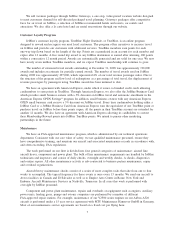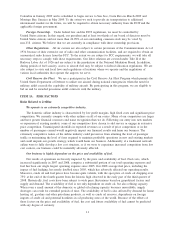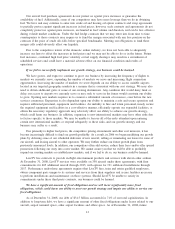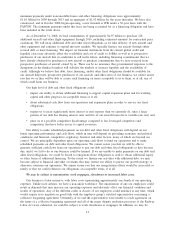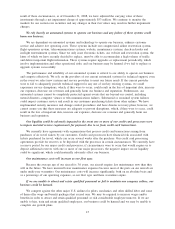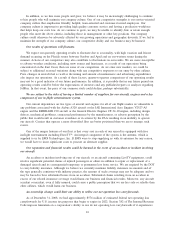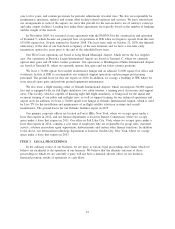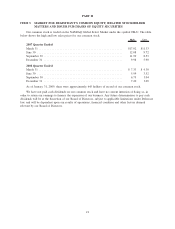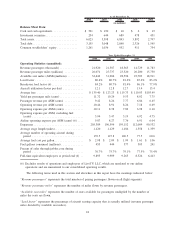JetBlue Airlines 2008 Annual Report Download - page 25
Download and view the complete annual report
Please find page 25 of the 2008 JetBlue Airlines annual report below. You can navigate through the pages in the report by either clicking on the pages listed below, or by using the keyword search tool below to find specific information within the annual report.In addition, as we hire more people and grow, we believe it may be increasingly challenging to continue
to hire people who will maintain our company culture. One of our competitive strengths is our service-oriented
company culture that emphasizes friendly, helpful, team-oriented and customer-focused employees. Our
company culture is important to providing high quality customer service and having a productive workforce
that helps keep our costs low. As we continue to grow, we may be unable to identify, hire or retain enough
people who meet the above criteria, including those in management or other key positions. Our company
culture could otherwise be adversely affected by our growing operations and geographic diversity. If we fail to
maintain the strength of our company culture, our competitive ability and our business may be harmed.
Our results of operations will fluctuate.
We expect our quarterly operating results to fluctuate due to seasonality, with high vacation and leisure
demand occurring on the Florida routes between October and April and on our western routes during the
summer. Actions of our competitors may also contribute to fluctuations in our results. We are more susceptible
to adverse weather conditions, including snow storms and hurricanes, as a result of our operations being
concentrated on the East Coast, than are some of our competitors. As we enter new markets, we could be
subject to additional seasonal variations along with any competitive responses to our entry by other airlines.
Price changes in aircraft fuel as well as the timing and amount of maintenance and advertising expenditures
also impact our operations. As a result of these factors, quarter-to-quarter comparisons of our operating results
may not be a good indicator of our future performance. In addition, it is possible that in any future period our
operating results could be below the expectations of investors and any published reports or analyses regarding
JetBlue. In that event, the price of our common stock could decline, perhaps substantially.
We are subject to the risks of having a limited number of suppliers for our aircraft, engines and a key
component of our in-flight entertainment system.
Our current dependence on two types of aircraft and engines for all of our flights makes us vulnerable to
any problems associated with the Airbus A320 aircraft or the IAE International Aero Engines V2527-A5
engine and the EMBRAER 190 aircraft or the General Electric Engines CF-34-10 engine, including design
defects, mechanical problems, contractual performance by the manufacturers, or adverse perception by the
public that would result in customer avoidance or in actions by the FAA resulting in an inability to operate
our aircraft. Carriers that operate a more diversified fleet are better positioned than we are to manage such
events.
One of the unique features of our fleet is that every seat in each of our aircraft is equipped with free
in-flight entertainment including DirecTV». An integral component of the system is the antenna, which is
supplied to us by EMS Technologies, Inc. If EMS were to stop supplying us with its antennas for any reason,
we would have to incur significant costs to procure an alternate supplier.
Our reputation and financial results could be harmed in the event of an accident or incident involving
our aircraft.
An accident or incident involving one of our aircraft, or an aircraft containing LiveTV equipment, could
involve significant potential claims of injured passengers or others in addition to repair or replacement of a
damaged aircraft and its consequential temporary or permanent loss from service. We are required by the DOT
to carry liability insurance. Although we believe we currently maintain liability insurance in amounts and of
the type generally consistent with industry practice, the amount of such coverage may not be adequate and we
may be forced to bear substantial losses from an accident. Substantial claims resulting from an accident in
excess of our related insurance coverage would harm our business and financial results. Moreover, any aircraft
accident or incident, even if fully insured, could cause a public perception that we are less safe or reliable than
other airlines, which would harm our business.
An ownership change could limit our ability to utilize our net operation loss carryforwards.
As of December 31, 2008, we had approximately $576 million of estimated federal net operating loss
carryforwards for U.S. income tax purposes that begin to expire in 2022. Section 382 of The Internal Revenue
Code imposes limitation on a corporation’s ability to use its net operating loss carryforwards if it experiences
16



